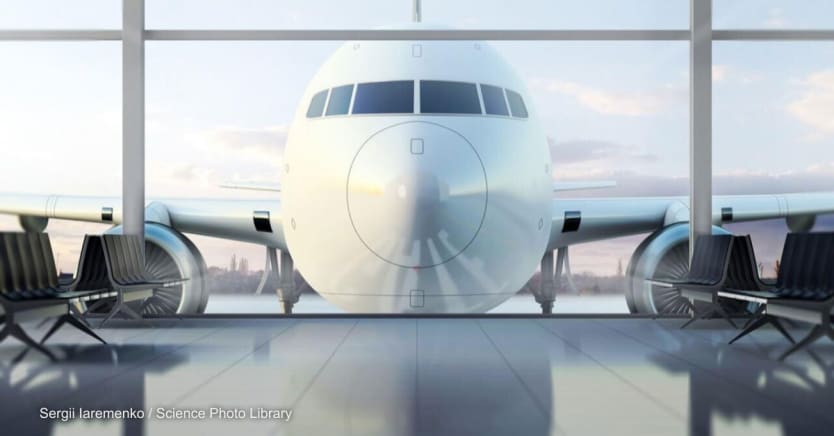
The COVID-19 pandemic has dramatically impacted populations, particularly through restrictive public health measures often adopted urgently. A key learning from this crisis is the importance of monitoring passenger flows to mitigate disease spread and avoid disrupting economic and social activities.
Earlier this year, when the infection rate was reaching a new peak in China, several governments feared that new variants could be exported to their countries — potentially escaping immunity from vaccines and previous contaminations. In view of this risk, some countries, including the United States, Belgium, Canada, and Malaysia, started to collect wastewater from airplanes arriving from China, to run genomic sequencing on samples and search for new variants.
Wastewater testing — which is recommended by the U.S. Centers for Disease Control and Prevention and the European Centre for Disease Prevention and Control — is an efficient way to identify biothreats among passengers through collective and nonintrusive sampling, respecting the confidentiality and privacy of individuals. The technique is also cost-efficient compared to individual testing of hundreds of people.
However, aircraft wastewater sequencing was not pursued in most countries, mostly because of the extended result processing time of a few days, as well as the high cost, making the approach difficult to scale.
With the idea of industrializing wastewater testing at a large scale for continuous monitoring, Swiss security provider SICPA and its partners have developed specific protocols, allowing for the testing of hundreds of airplanes in international hubs every day by combining a fast PCR-screening with a selective sequencing for samples with inconclusive immediate results.
This system, based on a PCR laboratory located inside the airport, coordinated with a sequencing laboratory that can be national or located abroad, provides multiple valuable insights to health authorities and contributes to building an efficient biosecurity border control.
Optimizing health systems’ efficiency
The first outcome is an early-warning system, which allows the identification of an immediate risk on an aircraft. SICPA’s PCR screening technique provides a result within less than two hours after landing. The tool can thus mitigate the risk of importing biothreats to a country and health authorities retain the option of intervening through an adapted public health decision, based on real-time measures.
The second outcome is to build an epidemiologic data collection, providing real-time cartography with the risk per country of provenance. After a few months of testing, it gives the epidemic seasonality across the globe — for example for influenza — information on the strains’ circulation per region and insights potentially leading to the discovery of new pathogens or variants.
Collecting all this information supports health authorities in making better decisions and optimizing the efficiency of health systems. For example, it can be used to inform national physicists of a pathogen’s arrival in the country, so they can react faster in case of observing characteristic symptoms in patients.
It also makes sense to combine aircraft wastewater testing with community wastewater testing, to not only track the arrival of a biothreat but also its spread among the population — and to take local actions if needed.
Improved understanding of epidemic dynamics
From an epidemiologic perspective and from a risk monitoring perspective, it is important to screen all landing airplanes arriving in a country, as a biothreat can come from anywhere. With experience in testing more than 700 airplanes, SICPA can confirm that it is as relevant to test short-haul as long-haul flights. When there is an epidemic situation in a country, pathogens are also detected in short-haul flights most of the time. Interestingly, a strong correlation was observed between the testing measures and the reality of the epidemic’s situation in the country of provenance, based on hospital admission statistics.
This sustainable system can be deployed within a few weeks in an airport. However, there are challenges when implementing such an end-to-end service — from sample collection to on-site laboratory analysis and real-time result visualization on a secure data platform. Beyond the elaboration of protocols, expertise is required to organize the logistics, the secure traceability of samples and data, the waste management process, and to integrate a complex and secure environment without disrupting passenger flows or existing processes inside the airport. It also requires authorizations from airliners engineering teams, coordination with ground handling companies, and the deployment of significant resources, operating 24/7.
From a technical perspective, another challenge is that such a system should adapt to the threat evolution to remain accurate, which pushed SICPA and its partners to develop industrial capacities to constantly update and extend the detection capabilities.
Creating a network of airports exchanging such epidemiologic data could also bring global visibility with real-time heatmaps. It would improve the understanding of epidemic dynamics and virus strains circulation around the globe. Duplicating the system with similar protocols in a few regions of the world would give a great opportunity to build a global health surveillance network and reinforce the scientific cooperation between health authorities and global organizations.
Visit the Pandemic Preparedness series for details on how we can implement health security solutions for a safer planet. Join the conversation by using the hashtag #PandemicPreparedness.


